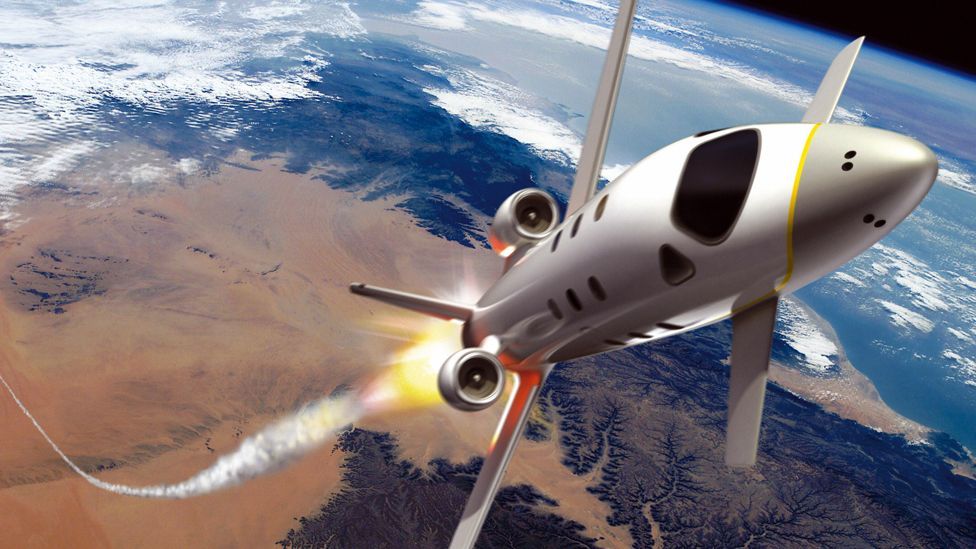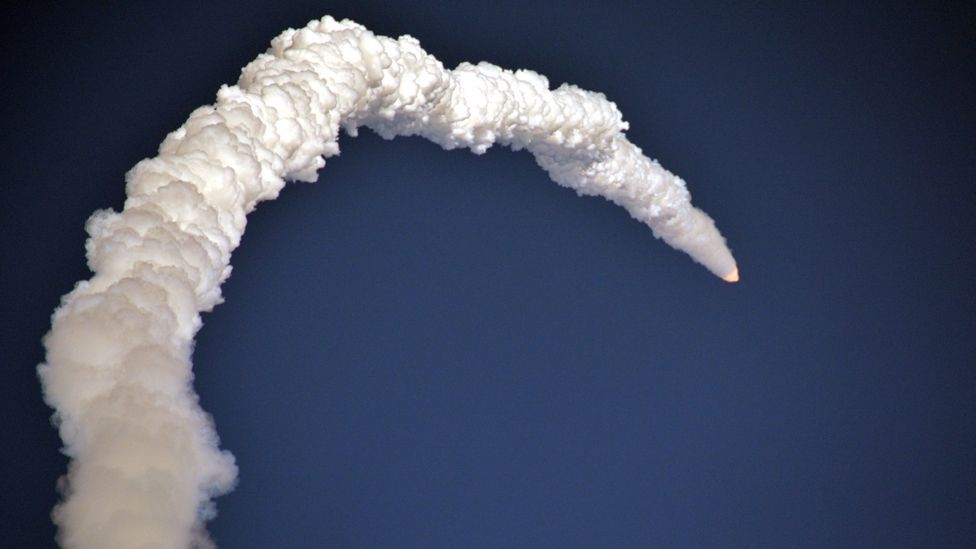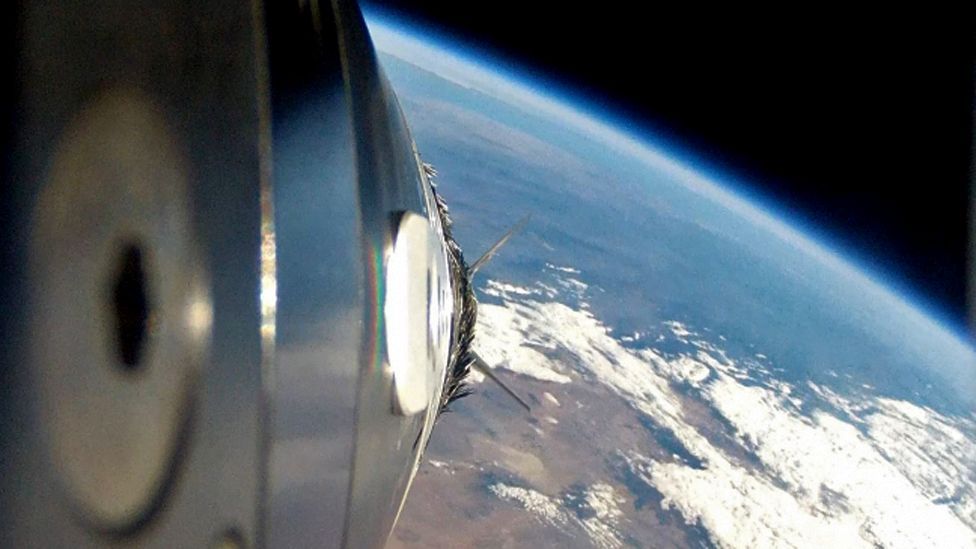Right now, one of the most exciting space facilities in the world is a World War Two hangar in the Mojave Desert in California.
The wooden hangar belongs to Xcor, one of the start-up companies building rocket planes to fly tourists into space. In the hangar next door, you can glimpse Virgin Galactic’s spaceplane, slung beneath its carrier aircraft. Further along the runway, Microsoft billionaire Paul Allen’s company, Stratolaunch, is developing a new space launch system. Eleven other small space businesses are spread around the site at the Mojave Air and Space Port.
Later this year, Virgin aims to fly its first paying passengers into space. The experience will not come cheap. Virgin Galactic is charging $250,000 for the privilege of experiencing five minutes of weightlessness; Xcor plans to charge $95,000 for a ride in its two-seater rocket ship. The cost alone puts this fledgling space-tourism industry beyond the means of most of us.
So it is easy to dismiss the whole enterprise as private jets in space rather than benefits for all mankind
Here are Six reasons Space tourism matters
1. It frees space ambitions from traditional burdens
The audacious plan to put men on the Moon was championed by politicians and backed with billions of taxpayer dollars. By the time men had actually stepped onto the lunar surface, Nasa’s budget was already being cut. Subsequent US, Russian and European space programmes – from the Shuttle to the International Space Station (ISS) – have suffered from political compromise and lack of ambition.
Story continues below

Private space travel companies using reusable spaceplanes could help boost space exploration (AFP/Getty Images)
Private spaceflight, on the other hand, is unburdened by the favour of taxpayers or whims of politicians. If the company can raise the cash, it can build a spacecraft. Inevitably, this free market favours people who already have a lot of money. But that is not true of all the companies in the private space business.
“We don’t have a multi-billionaire funding us,” admits the CEO of Xcor, Jeff Greason. For him, building a sub-orbital tourist craft is part of a long-term strategy. “We started examining how a fully-reusable orbital system would look and realised we would need to develop earlier versions of that to learn how to build them,” he says. “Those earlier versions also have to make money.”
2. Failure is now an option
Nasa is forever burdened with the phrase “failure is not an option”. Private companies have no such restrictions until the money runs out.
The entrance to the Mojave Air and Space Port is dominated by a reminder that not all space projects succeed. Resembling a giant white traffic cone, the Rotary Rocket is one of the most peculiar flying machines ever built – probably best described as half-helicopter, half-spacecraft, and if you were being cruel, you might also call the concept half-baked.
It was one of the first spacecraft to be developed at Mojave and, in 1999, made some brief atmospheric test flights. The engineering proved sound but funding problems caused the company to fold. Today it is gathering desert dust in a small memorial garden.
One person who worked on the Rotary is Kevin Mickey, President of Scaled Composites – the company now building Virgin’s spaceplane. “I look at this, and I’m proud of it,” says Mickey, as we stand beside the white conical spacecraft.
“One of the hurdles in today’s society is an intolerance for risk and failure and if you are truly going to innovate, you are going to fail sometimes,” he says. The carbon composite materials technology that went into the Rotary is now being adapted for Scaled Composite’s aircraft and spaceplanes, so the expertise has not totally gone to waste.
3. It will inspire a new generation of engineers
The spaceport looks more like a college campus than a space centre. Take, for example, 26-year-old Xcor engineer, Jeremy Voigt. He proudly shows me one of the rocket engines he is helping to develop: currently, it’s a mass of pipes, wires and valves.

Rockets can only be launched once - and can cost up to $12m a time (AFP/Getty Images)
“It’s the engineer’s dream job,” he says. “Most engineers sit behind a desk all day, I don’t. I get to come out here in the shop, turn wrenches and fire rocket engines.”
He looks around the crowded hangar, crammed with bits of rocket motor and partially constructed spaceplane. “If I was at Nasa, I would be part of a large team of engineers working on something,” he says excitedly. “Here I actually lead the rocket test, I get to push the button.”
The way of working at Mojave, in small teams with limited resources, is completely different to the way the space agencies work. Many people compare what is going on at Mojave with the early days of Silicon Valley and it is easy to draw parallels between the garage where Steve Jobs and Steve Wozniak built the first Apple computer, and the Xcor workshop. Maybe the young engineers here will have equally world-changing effects.
4. The cost of reaching space will go down
Right now, if you want to launch a satellite, it will cost upwards of $12m and that is before the compulsory insurance (which can sometimes double the price). Not only can conventional space rockets only be used once, they are extremely expensive to launch – and there is limited competition.
Compare that with the $250,000 cost of a flight on the reusable Virgin spaceplane. Scientific institutions have already signed up to fly experiments on these sub-orbital flights. If the next generation of space planes can reach orbit then that will massively reduce the cost of getting into space.
This means we will be able to launch satellites, spacecraft and space exploration missions for a fraction of the cost. The final frontier could finally become economically viable to a lot more people.
It is certainly something that gets CEO of Virgin Galactic and ex-Nasa employee, George Whitesides excited. “By lowering the cost of space access, we’ll be able to do things like sending little nanosats all over the Solar System and do all this incredible science, that is so expensive now,” he says. “If we are able to tackle some of these challenges by demonstrating access to space technologies, then I think that will be profound.”
5. Hypersonic travel could become a possibility
Remember the idea that you can take off from London, fly into space and touch down in San Francisco an hour or so later? When discussing technologies that are promised but never quite deliver, a close runner-up behind flying cars has to be so-called sub-orbital point-to-point travel. Could the space tourism companies at Mojave finally help make this dream a reality? George Whitesides thinks so: “This is fundamentally transformational for humanity,” he tells me.

How much would you be willing to pay for a view like this? (Nasa)
“I really think of our customers as pioneers, opening up the new frontier,” he says. “For one thing, everyone would like to get there faster, another reason is that you’re not chugging through the atmosphere for 12 hours, so there could be environmental benefits to that.”
But few people are going to pay $250,000, or even $95,000, for a flight to San Francisco, however fast. Space tourism companies counter with the argument that as the technology evolves, costs will inevitably come down. The history of aviation suggests this is indeed the case.
“Most technologies at the front end are funded by wealthier folks,” says Whitesides. “If you go back to the dawn of commercial aviation, the real adjusted cost of crossing the Atlantic was $10,000 or if you look at the early cellphones they were thousands of dollars, now you can get them for free if you sign up for a contract.”
Right now, the space companies are only on their first-generation rocket planes. By the 10th generation, point-to-point travel via space may become a reality.
6. It will provide a new view of our planet
It is widely accepted that one of the greatest achievements of the Apollo Moon programme was the view of the Earth from space. Apollo 8 astronaut Bill Anders summed up the impact of the pictures captured by his mission: “We came all this way to explore the Moon,” he said, “and the most important thing is that we discovered the Earth”. The images put us in our place, a blue marble against the backdrop of nothingness.
Every astronaut I have interviewed talks about how seeing the Earth from space changed their view of the world. So imagine what would happen if we started sending business and political leaders into space and back? Would that view of the world change them in the way it affected astronauts? And as a result, could it influence the decisions they make on border disputes, pollution or climate change?
Source: https://www.bbc.com/future/article/20140408-six-reasons-space-tourism-matters
No comments:
Post a Comment